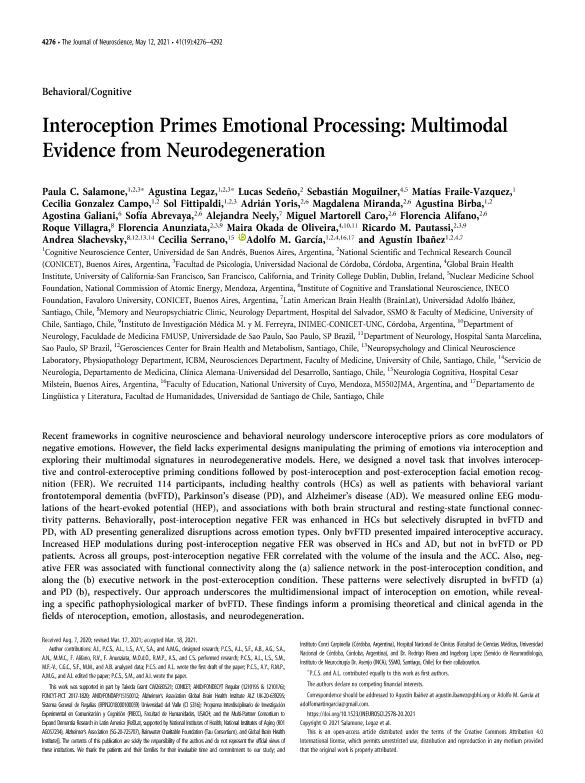Artículo
Interoception primes emotional processing: multimodal evidence from neurodegeneration
Salamone, Paula Celeste ; Legaz, Agustina
; Legaz, Agustina ; Sedeño, Lucas
; Sedeño, Lucas ; Moguilner, Sebastian Gabriel; Fraile Vázquez, Matías; Gonzalez Campo, Cecilia
; Moguilner, Sebastian Gabriel; Fraile Vázquez, Matías; Gonzalez Campo, Cecilia ; Fittipaldi, María Sol
; Fittipaldi, María Sol ; Yoris, Adrián Isidro
; Yoris, Adrián Isidro ; Miranda, Magdalena
; Miranda, Magdalena ; Birba, Agustina
; Birba, Agustina ; Galiani, Agustina; Abrevaya, Sofia
; Galiani, Agustina; Abrevaya, Sofia ; Neely, Alejandra; Martorell Caro, Miguel Angel
; Neely, Alejandra; Martorell Caro, Miguel Angel ; Alifano Ferrero, Florencia
; Alifano Ferrero, Florencia ; Villagra, Roque; Anunziata, Florencia
; Villagra, Roque; Anunziata, Florencia ; Oliveira, Maira Okada de; Pautassi, Ricardo Marcos
; Oliveira, Maira Okada de; Pautassi, Ricardo Marcos ; Slachevsky, Andrea; Serrano, Cecilia Mariela; García, Adolfo Martín
; Slachevsky, Andrea; Serrano, Cecilia Mariela; García, Adolfo Martín ; Ibáñez, Santiago Agustín
; Ibáñez, Santiago Agustín
 ; Legaz, Agustina
; Legaz, Agustina ; Sedeño, Lucas
; Sedeño, Lucas ; Moguilner, Sebastian Gabriel; Fraile Vázquez, Matías; Gonzalez Campo, Cecilia
; Moguilner, Sebastian Gabriel; Fraile Vázquez, Matías; Gonzalez Campo, Cecilia ; Fittipaldi, María Sol
; Fittipaldi, María Sol ; Yoris, Adrián Isidro
; Yoris, Adrián Isidro ; Miranda, Magdalena
; Miranda, Magdalena ; Birba, Agustina
; Birba, Agustina ; Galiani, Agustina; Abrevaya, Sofia
; Galiani, Agustina; Abrevaya, Sofia ; Neely, Alejandra; Martorell Caro, Miguel Angel
; Neely, Alejandra; Martorell Caro, Miguel Angel ; Alifano Ferrero, Florencia
; Alifano Ferrero, Florencia ; Villagra, Roque; Anunziata, Florencia
; Villagra, Roque; Anunziata, Florencia ; Oliveira, Maira Okada de; Pautassi, Ricardo Marcos
; Oliveira, Maira Okada de; Pautassi, Ricardo Marcos ; Slachevsky, Andrea; Serrano, Cecilia Mariela; García, Adolfo Martín
; Slachevsky, Andrea; Serrano, Cecilia Mariela; García, Adolfo Martín ; Ibáñez, Santiago Agustín
; Ibáñez, Santiago Agustín
Fecha de publicación:
05/2021
Editorial:
Society for Neuroscience
Revista:
Journal of Neuroscience
ISSN:
0270-6474
Idioma:
Inglés
Tipo de recurso:
Artículo publicado
Clasificación temática:
Resumen
Recent frameworks in cognitive neuroscience and behavioral neurology underscore interoceptive priors as core modulators of negative emotions. However, the field lacks experimental designs manipulating the priming of emotions via interoception and exploring their multimodal signatures in neurodegenerative models. Here, we designed a novel task that involves interoceptive and control-exteroceptive priming conditions followed by post-interoception and post-exteroception facial emotion recognition (FER). We recruited 114 participants, including healthy controls (HCs) as well as patients with behavioral variant frontotemporal dementia (bvFTD), Parkinson's disease (PD), and Alzheimer's disease (AD). We measured online EEG modulations of the heart-evoked potential (HEP), and associations with both brain structural and resting-state functional connectivity patterns. Behaviorally, post-interoception negative FER was enhanced in HCs but selectively disrupted in bvFTD and PD, with AD presenting generalized disruptions across emotion types. Only bvFTD presented impaired interoceptive accuracy. Increased HEP modulations during post-interoception negative FER was observed in HCs and AD, but not in bvFTD or PD patients. Across all groups, post-interoception negative FER correlated with the volume of the insula and the ACC. Also, negative FER was associated with functional connectivity along the (a) salience network in the post-interoception condition, and along the (b) executive network in the post-exteroception condition. These patterns were selectively disrupted in bvFTD (a) and PD (b), respectively. Our approach underscores the multidimensional impact of interoception on emotion, while revealing a specific pathophysiological marker of bvFTD. These findings inform a promising theoretical and clinical agenda in the fields of nteroception, emotion, allostasis, and neurodegeneration.
Archivos asociados
Licencia
Identificadores
Colecciones
Articulos(INCYT)
Articulos de INSTITUTO DE NEUROCIENCIAS COGNITIVAS Y TRASLACIONAL
Articulos de INSTITUTO DE NEUROCIENCIAS COGNITIVAS Y TRASLACIONAL
Articulos(SEDE CENTRAL)
Articulos de SEDE CENTRAL
Articulos de SEDE CENTRAL
Citación
Salamone, Paula Celeste; Legaz, Agustina; Sedeño, Lucas; Moguilner, Sebastian Gabriel; Fraile Vázquez, Matías; et al.; Interoception primes emotional processing: multimodal evidence from neurodegeneration; Society for Neuroscience; Journal of Neuroscience; 41; 19; 5-2021; 4276-4292
Compartir
Altmétricas



